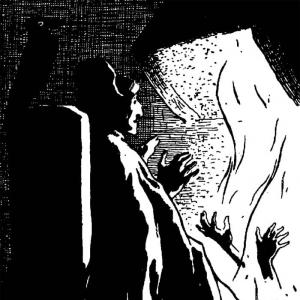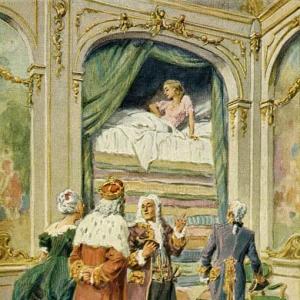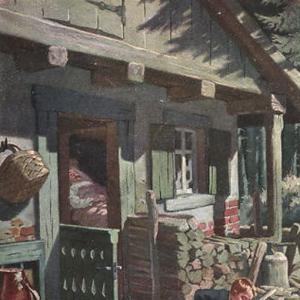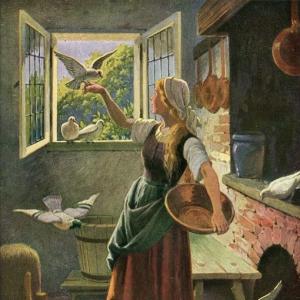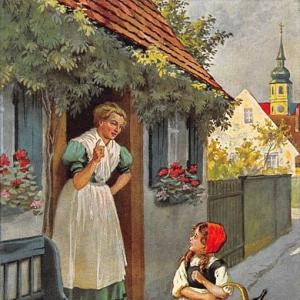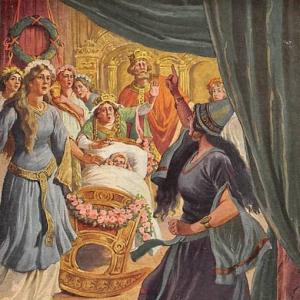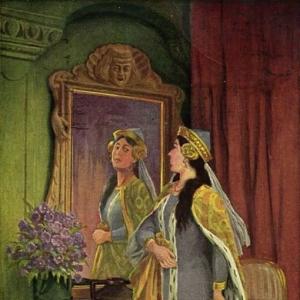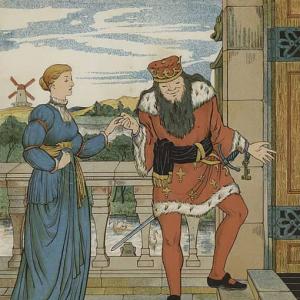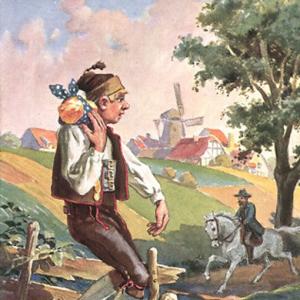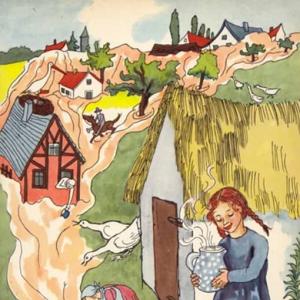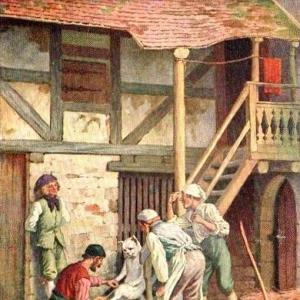Reading time: 13 min
The flax was in full bloom. It had pretty little blue flowers as delicate as the wings of a moth, or even more so. The sun shone, and the showers watered it; and this was just as good for the flax as it is for little children to be washed and then kissed by their mother. They look much prettier for it, and so did the flax.
„People say that I look exceedingly well,“ said the flax, „and that I am so fine and long that I shall make a beautiful piece of linen. How fortunate I am. It makes me so happy, it is such a pleasant thing to know that something can be made of me. How the sunshine cheers me, and how sweet and refreshing is the rain; my happiness overpowers me, no one in the world can feel happier than I am.“
„Ah, yes, no doubt,“ said the fern, „but you do not know the world yet as well as I do, for my sticks are knotty;“ and then it sung quite mournfully–
„Snip, snap, snurre,
Basse lurre:
The song is ended.“
„No, it is not ended,“ said the flax. „To-morrow the sun will shine, or the rain descend. I feel that I am growing. I feel that I am in full blossom. I am the happiest of all creatures.“
Well, one day some people came, who took hold of the flax, and pulled it up by the roots. This was painful. Then it was laid in water as if they intended to drown it; and, after that, placed near a fire as if it were to be roasted; all this was very shocking.
„We cannot expect to be happy always,“ said the flax; „by experiencing evil as well as good, we become wise.“
And certainly there was plenty of evil in store for the flax. It was steeped, and roasted, and broken, and combed; indeed, it scarcely knew what was done to it. At last it was put on the spinning wheel. „Whirr, whirr,“ went the wheel so quickly that the flax could not collect its thoughts.
„Well, I have been very happy,“ he thought in the midst of his pain, „and must be contented with the past;“ and contented he remained till he was put on the loom, and became a beautiful piece of white linen. All the flax, even to the last stalk, was used in making this one piece.
„Well, this is quite wonderful. I could not have believed that I should be so favored by fortune. The fern was not wrong with its song of
‚Snip, snap, snurre,
Basse lurre.‘
But the song is not ended yet, I am sure. It is only just beginning. How wonderful it is, that after all I have suffered, I am made something of at last. I am the luckiest person in the world– so strong and fine; and how white, and what a length! This is something different to being a mere plant and bearing flowers. Then I had no attention, nor any water unless it rained; now, I am watched and taken care of. Every morning the maid turns me over, and I have a shower-bath from the watering-pot every evening. Yes, and the clergyman’s wife noticed me, and said I was the best piece of linen in the whole parish. I cannot be happier than I am now.“
After some time, the linen was taken into the house, placed under the scissors, and cut and torn into pieces, and then pricked with needles. This certainly was not pleasant; but at last it was made into twelve garments of that kind which people do not like to name, and yet everybody should wear one.
„See, now, then,“ said the flax; „I have become something of importance. This was my destiny. It is quite a blessing. Now I shall be of some use in the world, as everyone ought to be. It is the only way to be happy. I am now divided into twelve pieces, and yet we are all one and the same in the whole dozen. It is most extraordinary good fortune.“
Years passed away, and at last the linen was so worn it could scarcely hold together.
„It must end very soon,“ said the pieces to each other; „we would gladly have held together a little longer, but it is useless to expect impossibilities.“ And at length they fell into rags and tatters, and thought it was all over with them, for they were torn to shreds, and steeped in water, and made into a pulp, and dried, and they knew not what besides, till all at once they found themselves beautiful white paper.
„Well, now, this is a surprise; a glorious surprise too,“ said the paper. „I am now finer than ever, and I shall be written upon, and who can tell what fine things I may have written upon me. This is wonderful luck!“ And sure enough the most beautiful stories and poetry were written upon it, and only once was there a blot, which was very fortunate. Then people heard the stories and poetry read, and it made them wiser and better. For all that was written had a good and sensible meaning, and a great blessing was contained in the words on this paper.
„I never imagined anything like this,“ said the paper, „when I was only a little blue flower, growing in the fields. How could I fancy that I should ever be the means of bringing knowledge and joy to man? I cannot understand it myself, and yet it is really so. Heaven knows that I have done nothing myself, but what I was obliged to do with my weak powers for my own preservation; and yet I have been promoted from one joy and honor to another. Each time I think that the song is ended; and then something higher and better begins for me. I suppose now I shall be sent on my travels about the world, so that people may read me. It cannot be otherwise; indeed, it is more than probable. For I have more splendid thoughts written upon me, than I had pretty flowers in olden times. I am happier than ever.“
But the paper did not go on its travels. It was sent to the printer, and all the words written upon it were set up in type, to make a book, or rather, many hundreds of books. For so many more persons could derive pleasure and profit from a printed book, than from the written paper; and if the paper had been sent around the world, it would have been worn out before it had got half through its journey.
„This is certainly the wisest plan,“ said the written paper; „I really did not think of that. I shall remain at home, and be held in honor, like some old grandfather, as I really am to all these new books. They will do some good. I could not have wandered about as they do. Yet he who wrote all this has looked at me, as every word flowed from his pen upon my surface. I am the most honored of all.“
Then the paper was tied in a bundle with other papers, and thrown into a tub that stood in the washhouse. „After work, it is well to rest,“ said the paper, „and a very good opportunity to collect one’s thoughts. Now I am able, for the first time, to think of my real condition; and to know one’s self is true progress. What will be done with me now, I wonder? No doubt I shall still go forward. I have always progressed hitherto, as I know quite well.“
Now it happened one day that all the paper in the tub was taken out, and laid on the hearth to be burnt. People said it could not be sold at the shop, to wrap up butter and sugar, because it had been written upon. The children in the house stood round the stove. For they wanted to see the paper burn, because it flamed up so prettily, and afterwards, among the ashes, so many red sparks could be seen running one after the other, here and there, as quick as the wind. They called it seeing the children come out of school, and the last spark was the schoolmaster. They often thought the last spark had come; and one would cry, „There goes the schoolmaster;“ but the next moment another spark would appear, shining so beautifully. How they would like to know where the sparks all went to! Perhaps we shall find out some day, but we don’t know now.
The whole bundle of paper had been placed on the fire, and was soon alight. „Ugh,“ cried the paper, as it burst into a bright flame; „ugh.“ It was certainly not very pleasant to be burning; but when the whole was wrapped in flames, the flames mounted up into the air, higher than the flax had ever been able to raise its little blue flower, and they glistened as the white linen never could have glistened. All the written letters became quite red in a moment, and all the words and thoughts turned to fire.
„Now I am mounting straight up to the sun,“ said a voice in the flames; and it was as if a thousand voices echoed the words; and the flames darted up through the chimney, and went out at the top. Then a number of tiny beings, as many in number as the flowers on the flax had been, and invisible to mortal eyes, floated above them. They were even lighter and more delicate than the flowers from which they were born; and as the flames were extinguished, and nothing remained of the paper but black ashes, these little beings danced upon it; and whenever they touched it, bright red sparks appeared. „The children are all out of school, and the schoolmaster was the last of all,“ said the children. It was good fun, and they sang over the dead ashes,–
„Snip, snap, snurre,
Basse lure:
The song is ended.“
But the little invisible beings said, „The song is never ended. The most beautiful is yet to come.“
But the children could neither hear nor understand this, nor should they. For children must not know everything.
 Learn languages. Double-tap on a word.Learn languages in context with Childstories.org and Deepl.com.
Learn languages. Double-tap on a word.Learn languages in context with Childstories.org and Deepl.com.Backgrounds
Interpretations
Adaptions
Summary
Linguistics
„The Flax“ is a fairy tale written by the Danish author Hans Christian Andersen. Born on April 2, 1805, and passing away on August 4, 1875, Andersen is one of the most renowned authors in the world of children’s literature. He is best known for his fairy tales, which have been translated into more than 125 languages and continue to be cherished by readers of all ages.
Hans Christian Andersen began publishing his fairy tales in 1835 with his first collection titled „Eventyr, fortalte for Børn“ („Fairy Tales, Told for Children“). These stories were not initially well-received, but over time, Andersen gained recognition, and his work became increasingly popular both in Denmark and internationally. His stories often contain elements of fantasy, morality, and inspiration drawn from his own life experiences, as well as from folklore and other literary sources.
Some of Andersen’s most famous works include „The Little Mermaid,“ „The Ugly Duckling,“ „The Emperor’s New Clothes,“ „The Snow Queen,“ and „Thumbelina.“ His stories often delve into themes of transformation, resilience, and the search for one’s purpose in life, as seen in „The Flax.“
„The Flax“ is a lesser-known fairy tale compared to some of Andersen’s other works, but it continues to resonate with readers due to its enduring themes and thought-provoking interpretations. Like many of his stories, „The Flax“ has been passed down through generations, sharing its timeless messages about the importance of resilience, finding meaning, and embracing change.
„The Flax“ by Hans Christian Andersen can be interpreted on various levels:
Resilience and Transformation: The story of the flax demonstrates the importance of resilience in the face of adversity. Despite enduring multiple hardships, the flax continues to adapt and evolve, transforming into new forms, each more valuable than the last. This message encourages readers to embrace change and growth, even when faced with challenging circumstances.
Purpose and Usefulness: The flax’s journey showcases the importance of finding purpose and being useful in life. From being a simple plant to becoming a valuable piece of paper, the flax continually discovers new ways to contribute positively to the world. This interpretation serves as a reminder for readers to seek meaning and value in their lives.
The Cycle of Life: The tale can also be viewed as an allegory for the cycle of life, from birth to death and rebirth. The flax goes through various stages, each representing a different phase of existence. The story suggests that there is beauty and purpose in every stage of life, even when it appears to be over, as demonstrated by the little invisible beings dancing on the ashes.
The Power of Stories: The transformation of the flax into paper and then into books highlights the significance of stories and their ability to educate, inspire, and bring people together. This interpretation underscores the importance of literature and the written word in enriching our lives and expanding our understanding of the world.
The Unseen Beauty: The presence of the little invisible beings, who dance on the ashes and claim that the most beautiful part of the story is yet to come, suggests that there is often unseen beauty and potential in even the most unexpected situations. This message encourages readers to remain hopeful and open to the possibility of hidden wonders in life.
„The Flax“ is a popular fairy tale by Hans Christian Andersen that has inspired several adaptations over the years. Here are a few examples.
Animated Films: „The Flax“ has been adapted into several animated films, including a 1986 Soviet film called „The Golden Flax“ and a 2010 Chinese film called „The Flax.“
Children’s Books: The story has been adapted into several children’s books, including „The Golden Flax“ by Niels Skov and „The Flax Maiden“ by Dawn Casey.
Stage Productions: „The Flax“ has been adapted for the stage in several productions, including a 1993 musical production by the Danish theater company Det Lille Teater.
Artistic Interpretations: The story has inspired several artistic interpretations, including a series of paintings by the Russian artist Ivan Bilibin and a sculpture by the Danish artist Jens Galschiot.
Literary Retellings: „The Flax“ has also been retold in various literary works, including the novel „The Flax of Dream“ by Henry Williamson and the short story „The Flax-Girl“ by Elizabeth Goudge.
Overall, „The Flax“ has proven to be a versatile and enduring fairy tale that continues to inspire new adaptations and interpretations in various forms of art and media.
„The Flax“ is a fairy tale by Hans Christian Andersen that follows the life of a flax plant as it experiences various transformations, discovering happiness and purpose in each stage. The story begins with the flax plant in full bloom, boasting beautiful blue flowers. Delighted by the sunshine and rain, the flax feels it is the happiest of all creatures.
One day, people uproot the flax and subject it to several harsh treatments, such as steeping, roasting, breaking, and combing. Despite the pain, the flax remains content, understanding that experiencing good and evil makes one wise. Eventually, it is spun into thread and woven into a beautiful piece of white linen, feeling fortunate and useful.
The linen is then made into twelve undergarments, and the flax is proud of its importance and usefulness in the world. As time passes, the linen wears thin and is eventually transformed into beautiful white paper. The paper is written upon with stories and poetry that inspire and educate people. The flax is overjoyed, realizing that it is now even more valuable than before.
However, instead of traveling the world, the paper is turned into books to reach more people. After serving its purpose, the paper is thrown into a fire, where it is burnt and turned into ashes. As the flames die, little invisible beings dance on the ashes, saying that the most beautiful part of the story is yet to come. Though the children watching the fire cannot hear or understand this message, the tale reminds us that there is beauty and purpose in every stage of life, even when it seems to be over.
Hans Christian Andersen’s fairy tale „The Flax“ offers a rich tapestry for linguistic analysis, weaving together themes of transformation, continuity, and metaphysical reflection through its narrative.
Here’s a linguistic breakdown of the tale:
Personification and Anthropomorphism
Throughout the tale, Andersen employs personification to give human qualities to the flax. The flax experiences emotions such as happiness and contentment, and it even engages in dialogue with other plants like the fern. This literary device not only creates a charming narrative but also allows the reader to explore a deeper understanding of identity and purpose.
Tone and Mood
The story maintains an optimistic tone despite moments of adversity. Even as the flax undergoes various transformations, it retains a sense of wonder and gratitude. Linguistically, this is achieved through the use of positive and hopeful language—words like „fortunate,“ „wonderful,“ and „happiness“ recurs consistently, imbuing the narrative with a sense of progression and positivity.
Repetition and Parallelism
Repetition plays a crucial role in Andersen’s tale, with phrases like „The song is ended“ and its variations prominently used throughout. These repetitions echo the cyclical nature of life and transformation, emphasizing the ongoing journey of the flax. This parallelism not only reinforces rhythm but also illustrates the narrative’s theme of perpetual change.
Symbolism
The transformation of flax into linen and then into paper and eventually into ashes represents a lifecycle that mirrors human experiences of growth, purpose, and renewal. The final transformation into flames and then into invisible entities suggests transcendence, aligning with the spiritual or existential implications of an eternity beyond physical form. Linguistically, the transitions are marked by vivid imagery and descriptive language that captures the reader’s imagination.
Dialogue and Voice
The tale uses direct speech to convey the inner thoughts of the flax and interactions with other characters, like the fern. The distinctive voice of the flax, expressed through self-reflection and acceptance, contrasts with the more skeptical voice of the fern, highlighting different perspectives on life’s experiences.
Moral and Philosophical Underpinnings
The layered use of linguistic devices serves to illuminate the story’s moral and philosophical questions regarding fate, contribution to the world, and the meaning of existence. Andersen embeds these themes in a narrative accessible to children, yet profound enough to provoke thought in adult readers.
Overall, Hans Christian Andersen’s „The Flax“ serves as an excellent example of how linguistic elements—personification, tone, repetition, symbolism, and dialogue—combine to create a tale that is both enchanting and introspective, exploring profound themes within a simple narrative structure.
Information for scientific analysis
Fairy tale statistics | Value |
|---|---|
| Translations | DE, EN, DA, ES, FR, IT, NL |
| Readability Index by Björnsson | 28.2 |
| Flesch-Reading-Ease Index | 80.7 |
| Flesch–Kincaid Grade-Level | 6.1 |
| Gunning Fog Index | 8.6 |
| Coleman–Liau Index | 7.7 |
| SMOG Index | 8.5 |
| Automated Readability Index | 5.7 |
| Character Count | 9.106 |
| Letter Count | 6.937 |
| Sentence Count | 105 |
| Word Count | 1.737 |
| Average Words per Sentence | 16,54 |
| Words with more than 6 letters | 202 |
| Percentage of long words | 11.6% |
| Number of Syllables | 2.246 |
| Average Syllables per Word | 1,29 |
| Words with three Syllables | 88 |
| Percentage Words with three Syllables | 5.1% |

 Facebook
Facebook  Whatsapp
Whatsapp  Messenger
Messenger  Telegram
Telegram Reddit
Reddit
